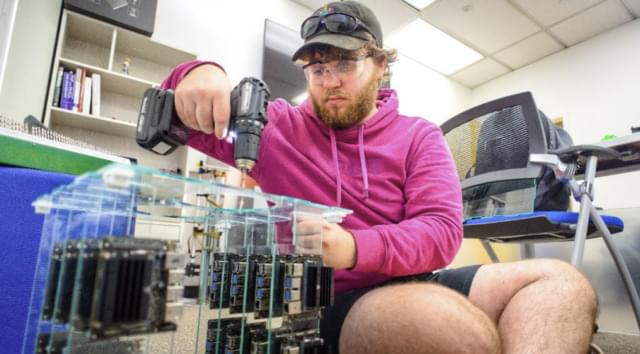It’s important to reach out to your doctor before changing or stopping a medication regimen.
Turing’s machine should sound familiar for another reason. It’s similar to the way ribosomes read genetic code on ribbons of RNA to construct proteins.
Cellular factories are a kind of natural Turing machine. What Leigh’s team is after would work the same way but go beyond biochemistry. These microscopic Turing machines, or molecular computers, would allow engineers to write code for some physical output onto a synthetic molecular ribbon. Another molecule would travel along the ribbon, read (and one day write) the code, and output some specified action, like catalyzing a chemical reaction.
Now, Leigh’s team says they’ve built the first components of a molecular computer: A coded molecular ribbon and a mobile molecular reader of the code.
Students at Southern Methodist University in Dallas are debuting their “baby” DIY supercomputer. It’s made of 16 NVIDIA Jetson Nano modules.
One can split an atomic nucleus to produce energy, but can you also split water to create environment-friendly hydrogen fuel? Doing so currently has two drawbacks: It is both time and energy intensive.
But now, researchers at Ben-Gurion University of the Negev in Beersheba and the Technion-Israel Institute of Technology in Haifa have taken a different path. BGU environmental physicist Prof. Arik Yochelis and Technion materials science professor Avner Rothschild believe they have identified new pathways that would speed up the catalytic process they think will reduce the invested electrical energy costs significantly.
Their splitting process is assisted by solar energy, which is known scientifically by the term photoelectrochemistry, and lowers the amount of the invested electrical energy needed to break the chemical bonds in the water molecule to generate hydrogen and oxygen. Oxygen evolution – the process of generating molecular oxygen (O2) by a chemical reaction, usually from water – requires the transfer of four electrons to create one oxygen molecule and then the adding of two hydrogen molecules to make water.
Researchers from Tokyo Metropolitan University have engineered a virtual reality (VR) remote collaboration system which lets users on Segways share not only what they see but also the feeling of acceleration as they move. Riders equipped with cameras and accelerometers can feedback their sensations to a remote user on a modified wheelchair wearing a VR headset. User surveys showed significant reduction in VR sickness, promising a better experience for remote collaboration activities.
Virtual reality (VR) technology is making rapid headway, letting users experience and share an immersive, 3D environment. In the field of remote work, one of the major advances it offers is a chance for workers in different locations to share what they see and hear in real-time.
An example is users on personal mobility devices in large warehouse facilities, factories, and construction sites. Riders can cover large areas with ease while highlighting issues in real-time to a remote co-worker. However, one major drawback can ruin the whole experience: VR sickness is a type of motion sickness which comes from users seeing “motion” through their headsets without actually moving. Symptoms include headaches, nausea, and sometimes vomiting. The problem is particularly acute for the example above, when the person sharing the experience is moving about.
AI could help doctors identify which skin cancer patients are at high-risk of a melanoma recurrence before their initial cancer is even treated — giving them…
NASA combined 18 all-sky images to create a timelapse of the night sky.
The Universe is over 13 billion years old, so a 12-year slice of that time might seem uneventful. But a timelapse movie from NASA shows how much can change in just over a decade.
There’s a certain insidiousness to the way glaucoma — a group of eye diseases that damage the optic nerve — can snatch away a person’s vision.
That damage can be so slow that people may never notice until it is too late, and the long term impacts, like loss of peripheral vision, blind spots, and blindness, have set in.
Glaucoma impacts tens of millions of people globally, and is the second leading cause of blindness, after cataracts. Now, Purdue University researchers have developed smart contact lenses that may help save people’s sight.
Experts do not want to hack it.
Juan Gilbert, a professor of computer science at the University of Florida, has claimed that he has built the ultimate unhackable voting machine that can put concerns to rest over machine-related voting, Undark.
Electronic voting systems have the U.S. divided, with advocates calling them reliable aides to the voting process, helping people with disabilities to vote, and reducing invalid ballots. On the other hand, critics have called for their boycott since they can be hacked and can tilt the vote in favor of a person or party.
Companies engaged in building voting machines, an industry with annual revenues of $300 million, do not help matters as they chose to remain secretive about how their machines work and refuse to talk to researchers or the press, the Undark report said. Under these circumstances, Gilbert’s work is commendable since he has built a system that works using open-source software.
“We face two global crises in housing and climate change.”
Southern California met its first-in-the-world 3D-printed zero net home thanks to Mighty Buildings. As part of a 40-unit community in Desert Hot Springs, these 3D-printed houses also draw attention to environmental and economic strategies.
“We are excited to be the first company in the world to complete what we believe to be the sustainable housing standard of the future,” said Mighty Buildings CEO Slava Solonitsyn, as per Dezeen.
Mighty Buildings.
As mentioned in the Dezeen, the 1,171 square foot (159 square meters) house was finished by the Oakland-based technology corporation in September 2022. The Quatro, a two-bedroom, two-bathroom home built by Ehrlich Yanai Rhee Chaney Architects (EYRC), is said to use a flexible, panelized kit of parts from Mighty Buildings to produce as much energy as it uses.









